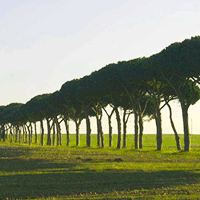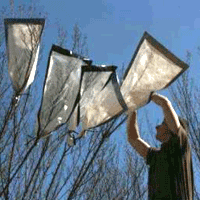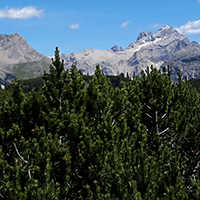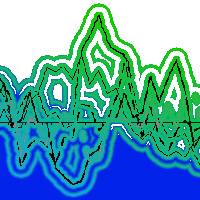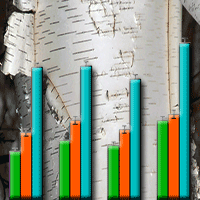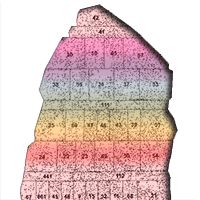
The growth dynamics of East European Scots pine (Pinus sylvestris L.) populations - a Lithuanian field trial
Edgaras Linkevičius (1), Giedrius Šidlauskas (1), Almantas Kliučius (1), Emilis Armoška (2), Marius Mikalajunas (1), Diana Sidabriene (1), Paulina Andriuškevičiute (1), Algirdas Augustaitis (1)
iForest - Biogeosciences and Forestry, Volume 17, Issue 2, Pages 59-68 (2024)
doi: https://doi.org/10.3832/ifor4359-016
Published: Mar 06, 2024 - Copyright © 2024 SISEF
Research Articles
Abstract
For the native Lithuanian Scots pine (Pinus sylvestris L.) population, rapidly changing climatic conditions raise new issues, related to survivability and resistance of local provenances to biotic and abiotic stressors. The aim of this study is to revise and update the findings of Abraitis & Ericsson (1996) who assessed the productivity of Scots pine provenances following 22 years of growth. In this study, we assessed the productivity of same provenances following 39 years of growth. This study was done based on a long-term pine provenance research experiment established in 1975 in Lithuania, as an integral part of the Prokazyn investigation that was launched across the former USSR. Our results indicate a clear effect of latitude as well as longitude on the mean stand performance values of Scots pine provenances. With increasing latitude, mean height, mean quadratic diameter and the volume of growing trees per hectare had a clear decreasing tendency. Except for the mean squared diameter, the impact of the longitude was the same on the mean stand height and the volume of growing trees per hectare. Ranking of Scots pine provenances based on breeding indices showed that provenances that were identified as the most productive ones by Abraitis & Ericsson (1996) after 17 years of growth, lost their top positions after 39 years of growth. In the case of demand for genetically improved planting material, it could be recommended to use southerner populations which demonstrate higher growth intensity up to 39 years.
Keywords
Scots Pine Provenances, Latitude, Longitude, Radial Growth, Seasonal Effects, Climatic Indicators
Authors’ Info
Authors’ address
Giedrius Šidlauskas 0009-0001-6262-4498
Almantas Kliučius 0000-0001-9135-766x
Marius Mikalajunas
Diana Sidabriene
Paulina Andriuškevičiute
Algirdas Augustaitis 0000-0003-3938-3611
Vytautas Magnus university, Agriculture Academy, Faculty of Forest Sciences and Ecology, Studentu 13, Akademija, LT-53362 Kaunas distr. (Lithuania)
Lithuanian Research Centre for Agriculture and Forestry, Instituto al. 1, Akademija, LT-58344 Kedainiai (Lithuania)
Corresponding author
Paper Info
Citation
Linkevičius E, Šidlauskas G, Kliučius A, Armoška E, Mikalajunas M, Sidabriene D, Andriuškevičiute P, Augustaitis A (2024). The growth dynamics of East European Scots pine (Pinus sylvestris L.) populations - a Lithuanian field trial. iForest 17: 59-68. - doi: 10.3832/ifor4359-016
Academic Editor
Andrea Cutini
Paper history
Received: Apr 07, 2023
Accepted: Nov 28, 2023
First online: Mar 06, 2024
Publication Date: Apr 30, 2024
Publication Time: 3.30 months
Copyright Information
© SISEF - The Italian Society of Silviculture and Forest Ecology 2024
Open Access
This article is distributed under the terms of the Creative Commons Attribution-Non Commercial 4.0 International (https://creativecommons.org/licenses/by-nc/4.0/), which permits unrestricted use, distribution, and reproduction in any medium, provided you give appropriate credit to the original author(s) and the source, provide a link to the Creative Commons license, and indicate if changes were made.
Web Metrics
Breakdown by View Type
Article Usage
Total Article Views: 16878
(from publication date up to now)
Breakdown by View Type
HTML Page Views: 12301
Abstract Page Views: 1775
PDF Downloads: 2511
Citation/Reference Downloads: 1
XML Downloads: 290
Web Metrics
Days since publication: 667
Overall contacts: 16878
Avg. contacts per week: 177.13
Citation Metrics
Article Citations
Article citations are based on data periodically collected from the Clarivate Web of Science web site
(last update: Mar 2025)
Total number of cites (since 2024): 1
Average cites per year: 0.50
Publication Metrics
by Dimensions ©
Articles citing this article
List of the papers citing this article based on CrossRef Cited-by.
References
Paprastosios pušies (Pinus sylvestris L.) vidurušines diferenciacijos ypatumai [The characteristics of the intra-specific differentiation of common pine (Pinus sylvestris L.) trees]. Miškininkyste 1: 57-63. [in Lithuanian]
Gscholar
Pinus sylvestris East European populations: growth behavior in one Lithuanian field trial. Baltic Forestry 2: 28-35.
Gscholar
Tree-ring formation as an indicator of forest capacity to adapt to the main threats of environmental changes in Lithuania. Science of the Total Environment 615: 1247-1261.
CrossRef | Gscholar
Scots pine provenance trials in Latvian SSR. Jaunakais Mezsaimnieciba 26: 37-48.
Gscholar
Miško medziu bandomuju zeldiniu vadovas Vi Kazlu Rudos mokomojoje mišku uredijojeo [Guide of experimental forest plants at the Kazlu Ruda State Forest Enterprise]. Lietuvos Mišku Institutas, Lutute, Kaunas distr. Lithuania, pp. 103. [in Lithuanian]
Gscholar
Summary of results on Scots pine (Pinus sylvestris L.) height growth in IUFRO provenance experiments. Silvae Genetica 28: 136-152.
Gscholar
A simulation model for managing jack-pine stands. In: “Growth Models for Tree and Stand Simulation” (Fries J ed). Royal College of Forestry, Stockholm, Sweden, pp. 74-90.
Gscholar
Provenance trials of conifers in south Siberia. In “Provenance Trials and Plantations of Conifers in Siberia”. Nauka, Novosibirsk, Russia, pp. 4-110.
Gscholar
Lietuvos medynu prieaugio ir jo panaudojimo normatyvai [Forest yield models and tables in Lithuania]. Girios Aidas, Kaunas, Lithuania, pp. 383. [in Lituanian]
Gscholar
Specific features of Scotch pine provenance trials in Angara River Basin. Lesovedenie 4: 23-29.
Gscholar
Zahlenmäßiges verfahren fur die Ausfuhrung der bestandeshöhenkurven [Numerical procedure for the generation of stand height curves]. Forstwissenschaftliches Centralblatt und Tharandter Forstliches Jahrbuch 6: 273-279. [in German]
Gscholar
Zum Einfluß des Baumverteilungsmusters auf den Bestandeszuwachs [Tree distribution patterns on stand growth]. Allgemeine Forst- und Jagdzeitung 166: 190-201.
Gscholar
Izucsenie imejusikszia novih gyeograficseszkih kultur (programa i metodika rabot) [Study of the displacement of new geographical cultures (program and methodology of work)]. Pushkino, All-Russian Forest and Melioration Research Institute (VNIILM), Pushkin, pp. 53. [in Russian]
Gscholar
Vergleichende untersuchungen zur Ermittlung der Genauigkeit bei der Ablotung von Kronenradien mit dem Dachlot und durch senkrechtes Anvisieren des Kronenrandes (Hochblick-Messung). Forstarchiv 2: 67-71. [in German]
Gscholar
Height growth variation in a comprehensive Eurasian provenance experiment of (Pinus sylvestris L.). Silvae Genetica 46: 332-349.
Gscholar
Productivity of geographical populations of Pinus sylvestris. Lesnoe Khozyaistvo 11: 36-38.
Gscholar
Lithuanian statistical yearbook of forestry. Lutute, Kaunas, Lithuania, pp. 183.
Gscholar
Exposé historique et descriptif de l’École forestizre des Parres przs de Nogent-Sur-Ver-nisson (Loiret) [Historical and descriptive overview of the Forest School of Parres near Nogent-Sur-Vernisson (Loiret)]. Memoires de La Societé Impériale et Centrale d’Agriculture de France, Paris, France, pp. 1-61. [in French]
Gscholar
Beytrag zur teutschen holzerechten forstwissenschaft: die anpflanzung nordamericanischer holzarten, mit anwendung auf teutsche forste betreffend [Contribution to German forestry rights: the planting of North American tree species, with application to German Forests]. JC Dieterich, Göttingen, Germany, pp. 124. [in German]
Gscholar

